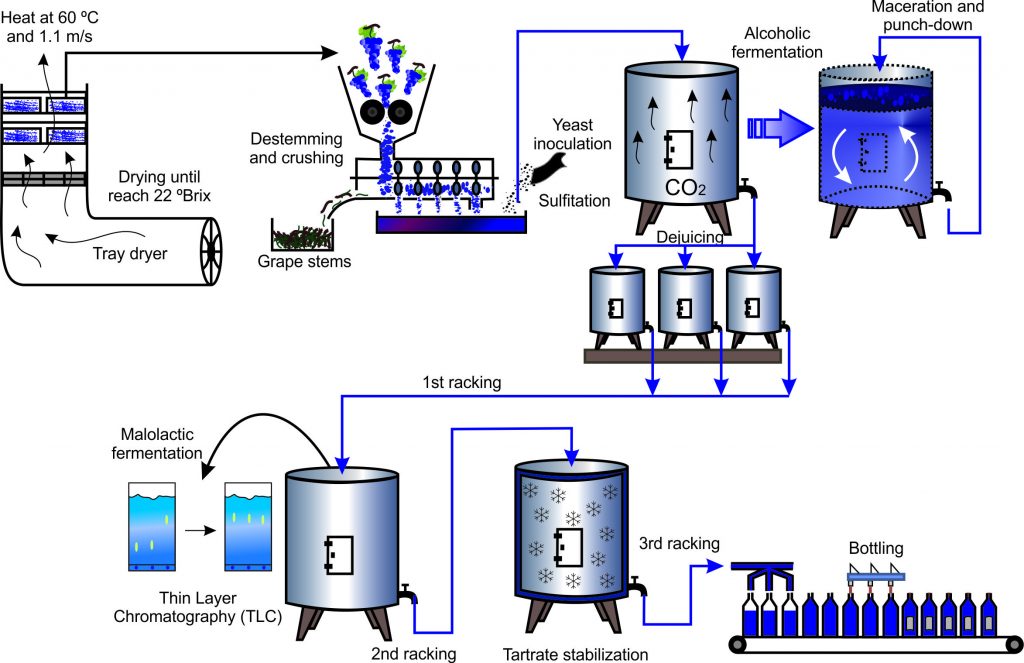By Maurício Castilhos
Brazil is a country with a discrete wine production when compared to the great world wine producers such as France, Italy and Spain. Wine production in Brazil is characterized by the relevant production of non Vitis vinifera and wines. These grapes are not well known worldwide, since they are not commonly used for wine production. With a fruity flavor and aroma, these grapes are very appreciated by the Brazilian consumers. There is a classical region that produces wines from non Vitis vinifera grapes and responds for more than 80% of the wines produced in Brazil.
With the aim of improving the quality of the Brazilian wines, some winemakers have employed different winemaking procedures to enhance wine color, to promote beneficial changes on wine aroma, and to enhance wine flavor, which result in wines highly appreciated by the consumers. Among the known winemaking procedures used in wineries, the grape pre-drying and the submerged cap attracted the attention of some researchers and winemakers since both procedures presented great chemical and sensory results.
In Brazil chaptalization procedure is allowed and consist in adding sucrose into the must to correct the alcoholic content of the resulted wine. This practice is allowed because Vitis labrusca Brazilian grapes do not reach enough sugar content, which is mandatory for producing wine with alcohol content between 8.6 and 14.0 % v/v. The grape pre-drying (Figure 1) consists in dry the grapes before the alcoholic fermentation aiming to increase grape soluble solid content. Grape pre-drying emerged as an alternative winemaking procedure to chaptalization one, since there are some studies reporting negative effects of chaptalization on wine features. Grape pre-drying procedure is based on the water evaporation aiming to concentrate the natural sugar present in grapes.

Some studies reported that the use of heat, even at low temperatures (about 60 ºC), degrade some phenolic compounds, such as anthocyanins, flavonols and hydroxycinnamic acid derivatives decreasing the antioxidant capacity of red wines. In contrast, the pre-dried wines presented higher flavan-3-ols concentrations when compared to wines elaborated with traditional winemaking procedures, originating wines with higher bitterness and astringency. Grape pre-drying results in important changes in red wines, promoting a jam note aroma, probably due to the significant presence of 2-phenylethyl acetate, which is considered as a positive change in Brazilian red wines, since it is well-accepted feature for consumers. Another positive result of the use of grape pre-drying is wine body enhancement, caused by water evaporation that concentrates grapes compounds.
Another winemaking procedure in Brazilian wineries, that can be considered as an alternative to the traditional winemaking one, is the submerged cap (Figure 2). This procedure promotes a constant contact between the solid parts (grape pomace) and the liquid part (grape must). The aim of this procedure is to enhance the release of grapes chemical compounds to must, improving chemical composition and causing a positive response on sensory features. Some studies also reported that the use of the submerged cap procedure enhance the yield of the winemaking reaching about 65 % of the total yield.

The submerged cap winemaking also provides some relevant results regarding the concentration of phenolic compounds, showing a discrete increase on the phenolic concentration. This result is probably linked with the constant contact between the must and pomace, enhancing the extraction of the phenolic compounds existent in the solid parts. The improvement of the phenolic concentration provides an intense color for the wine and some punctual changes regarding aroma and flavor. In a recent study, the submerged cap winemaking procedure provided a vegetal note on wines due to the higher concentration of C6 alcohols. In the same study, which provided information about the aroma of two non Vitis vinifera wines, the authors reiterated the fruity flavor of the wines mainly due to the presence of higher concentrations of ethyl and methyl esters and acetates.
Alternative winemaking procedures are suitable for wines, because these beverages presented high chemical and sensory complexity, which influence the high or low consumers acceptance. Since every sensory change has a chemical one that explains it, all the chemical changes observed due to the application of variations in winemaking will result in sensory changes, and these changes can be considered good or bad for the wine. In this context, the study of these alternative procedures is crucial for the improvement and evolution of the winemaking and wineries, producing wines with different chemical profiles and, consequently, different sensory features, which can be responsible for their higher acceptance.

Maurício Castilhos is graduated in Food Engineering, Master and PhD degree in Food Science and Engineering from São Paulo State University (Unesp), Institute of Biosciences, Humanities and Exact Sciences, São José do Rio Preto, SP, Brazil. Castilhos is Food Technology professor and researcher at Minas Gerais State University (Uemg), associate editor from Food Research International Journal, and have experience in alternative winemaking technologies and their influence on wine chemical and sensory properties. In addition, Castilhos have experience in phenolic and volatile composition using instrumental chemistry applying High Performance Liquid Chromatography Gas Chromatography, both coupled with Mass Spectrometry (HPLC-MSn / GC-MS), respectively. Recently has developed researchers concerning the wine metabolomics in order to fulfill the gap existent in Brazil regarding Geographical Indication of Provenance using HPLC-QTOF-MS-MS and Nuclear Magnetic Ressonance (NMR) analytical techniques. Castilhos also has experience in wine sensory analysis and statistical approaches, using them in order to improve the descriptive and acceptance wine sensory studies.
References:
- De Castilhos, M. B. M. & Del Bianchi, V. L. Winemaking procedures and their influence on wine stabilization: effect on the chemical profile. In Jordão, A. M. & Cosme, F. (editors), Recent Advances in Wine Stabilization and Conservation Technologies, Nova Science Publishers Inc., 2016.

